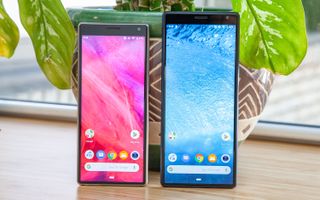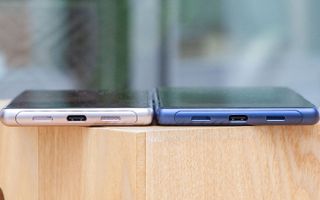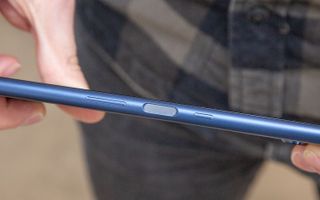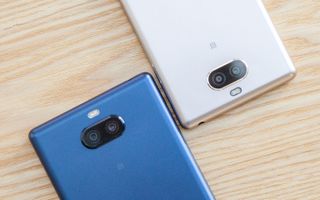Sony Xperia 10 Review: Style Over Substance
Sony set out to reboot its midrange smartphone lineup yet again, but the Xperia 10 and 10 Plus simply don't have the hardware it takes to rise to the top.
Why you can trust Tom's Guide

For 2019, Sony is reinventing its Xperia lineup — again. In a departure from last year's XA2 series, the company is outfitting its latest midrange handsets, the Xperia 10 and 10 Plus, with narrow and tall displays that adopt a cinema-like 21:9 aspect ratio when used in landscape mode.
That probably sounds like a gimmick, but it's actually the greatest thing about these devices. With a 21:9 screen, you can see more, when reading or watching certain videos, or do more, when you're flipping between tasks and running apps side by side.
Unfortunately however, everything else — from the unreliable cameras to the so-so battery life and abysmal performance (particularly in the case of the cheaper Xperia 10) — ultimately destroys any shot Sony's latest midrange offerings have at landing on our best smartphones list.
Price and Availability
Sony's new midrange handsets come in two flavors for 2019: the 6-inch Xperia 10 for $349 and the 6.5-inch Xperia 10 Plus for $429. Both are compatible primarily with GSM networks, though they're also certified to work on Verizon. There's only one configuration of each, with 64GB of onboard storage.
Both the Xperia 10 and 10 Plus are available in a range of colors, though not every option will be sold in all territories. In North America, only black and silver are on offer for both models. However, other regions will receive pink and navy, too.
Sony Xperia 10 and 10 Plus Specs
| Sony Xperia 10 | Sony Xperia 10 Plus | |
| Price | $349 | $429 |
| OS | Android 9 Pie | Android 9 Pie |
| Screen Size (Resolution) | 6-inch LCD (2520 x 1080); 21:9 aspect ratio | 6.5-inch LCD (2520 x 1080); 21:9 aspect ratio |
| CPU | Qualcomm Snapdragon 630 | Qualcomm Snapdragon 636 |
| RAM | 3GB | 4GB |
| Storage | 64GB | 64GB |
| microSD Slot | Yes, up to 512GB | Yes, up to 512GB |
| Rear Camera | Dual: 13 MP (f/2.0) and 5 MP (f/2.4) | Dual: 12 MP (f/1.8) and 8 MP telephoto (f/2.4) |
| Front Camera | 8 MP (f/2.0) | 8 MP |
| Battery Size | 2,870 mAh | 3,000 mAh |
| Battery Life (Hrs:Mins) | 8:05 | 8:46 |
| Water Resistance | No | No |
| Size | 6.1 x 2.7 x 0.3 inches | 6.6 x 2.9 x 0.3 inches |
Design: Pretty and pretty quirky
Sony's smartphones have always had a hyperminimalist design, and the Xperia 10 and 10 Plus are no exceptions. The two handsets are identically styled — save for the difference in size — and employ the same extra-tall 21:9 aspect ratio, Gorilla Glass 5, aluminum unibody chassis and side-mounted fingerprint sensors.

If it weren't for their narrow proportions, the Xperia 10 duo likely wouldn't stand out in a police lineup of midrange devices. However, these are still refined and attractive smartphones in that classically Sony way. I appreciate the company doubling down on aluminum when rivals are pumping out increasing numbers of cookie-cutter handsets clad in cheap-feeling glass. Additionally, the fit and finish of the Xperia 10 lineup is exceptional, lending a sense of quality to a segment of the market that rarely sees it.
The Xperia 10 and 10 Plus are still refined and attractive smartphones in that classically Sony way.
However, these phones look a bit strange at first glance, not only because of the elongated aspect ratio, but also because of how low their screens are positioned. The side and bottom bezels are all slim and fully consistent, but the top bezel is quite thick. Clearly, Sony had to find space to shoehorn in that display driver somewhere, and we wouldn't call the decision a deal breaker by any means. It has left both handsets feeling quite top heavy, though.

Sony fitted the Xperia 10 and 10 Plus with NFC for mobile payments, and thanks to the inclusion of the 3.5-millimeter jack, neither phone will force you down the path of USB Type-C or Bluetooth headphones just yet. At the bottom edge is a pair of grilles that seem like stereo speakers, though only one of them actually fires any sound. At least they look nice.
MORE: Best Smartphones - Here Are the 10 Best Phones Available
Strangely, Sony has returned to the fingerprint-sensor-in-the-frame motif that the company spurned in the Xperia XZ2 and XZ3 last year. The module works perfectly well, which is actually no small feat considering that Sony used to disable the feature for U.S.-bound phones for reasons it never fully explained.

However, the Xperia 10 line breaks out the sleep/wake button into a separate key above the scanner, which consequently leads to a somewhat nonintuitive user experience. Before I learned the proper muscle memory, I kept pressing deeper onto the sensor to wake each device — as I would do with Samsung's Galaxy S10e — only to be met with no response.
Display: More than a gimmick
Sony has fully bought in to the cinema experience with the Xperia 10 and 10 Plus. The two devices each employ an LCD display, with the same 21:9 aspect ratio and 2520 x 1080 resolution.
The unique proportions of these phones may seem like mere gimmickry, but there's a fair bit of practical merit behind the design. For one, having a panel that's taller in portrait orientation really helps when you're scrolling through web pages, apps and text-heavy content in general. When watching a video, switching to landscape can yield a more immersive experience — if the content being watched employs the same aspect ratio, that is.
The Xperia 10's cinema-wide display may prove its worth — provided you can find content that supports it.
That caveat is key, because you're unlikely to encounter lots of 21:9 content on YouTube, for example. If you watch a lot of feature films on your phone on Netflix, however, the Xperia 10's cinema-wide display may prove its worth.
Watching Guardians of the Galaxy Vol. 2, I felt as though I could see much more of the action as Star-Lord bobbed and weaved through enemy fire amidst the commotion of an epic space battle. It definitely helped that the colors were on point, as well, as both new Sony phones sport excellent color reproduction, sharpness and brightness. Those qualities really made the laser beams and explosions pop against the galaxy's darkest depths.
Both phones put up strong numbers across the board. The 6.5-inch Xperia 10 Plus led the 6-inch Xperia 10 on brightness, with a peak of 523 nits compared to the smaller phone's 501 nits. For reference, the Moto G7 gets up to 445 nits, which isn't poor by any means.
MORE: Apple's iPhone XS Max Has the Best Smartphone Display Ever
Coverage of the sRGB color space was also satisfactory in both Sony devices, reaching 108 percent on the 10 Plus and 128 percent on the Xperia 10, while each was turned to the default display profile. Those who prefer more-saturated images can always switch to the Super Vivid option.
Finally, the Xperia 10 duo posted accurate hues, as evidenced by the Delta-E scores of 0.55 and 0.54 for the Plus and standard variants, respectively. (Numbers closer to zero are better.) Both Sony handsets were slightly outclassed by the $299 Moto G7 and $349 Nokia 7.1 on colors, however, which led the pack with Delta-E scores of 0.34 and 0.33.
Cameras: Double trouble
The Xperia 10 and 10 Plus both come equipped with dual-lens rear cameras and have the same 8-megapixel, front-facing camera, though that's where the similarities end.

The regular Xperia 10 pairs a 13-MP, f/2.0 primary lens with a 5-MP secondary one for depth. The Xperia 10 Plus replaces that 13-MP shooter with a 12-MP one, albeit with a larger, f/1.8 aperture to let in more light. And instead of that measly 5-MP camera on the side, the Plus model gets an 8-MP telephoto — a rarity in a midrange phone.
Sony makes the majority of image sensors used in smartphones, which certainly inspires a lot of hope for the Xperia 10 family's imaging capabilities. And yet, even in ideal scenarios, these handsets rarely produce anything appreciably better than what you get from other similarly-priced offerings.
The Xperia 10 Plus got off to a strong start, rendering this cluster of flowers in New York’s Bryant Park with a warmth that was plainly lacking in the Moto G7’s attempt. I also like the nuance the 10 Plus exhibited with respect to the colors and contrast; Motorola’s handset dabbles exclusively in washed-out blues and whites within the flowers’ petals, whereas Sony’s shooter captures all the shades of lavender in between, and nails the lush greens underneath.
However, things unfortunately began to fall apart for Sony when the Xperia 10 churned out this bleak, desolate-looking shot from the edge of the park. The buildings, grass and street-level details are far too dark, while the sky is blown out and lacking in any depth. The G7 hardly fared much better, delivering a softer shot with a strange blue-green cast — though at least it was more brightly exposed, and you can see everything a bit more easily.
Given that the Xperia 10 Plus features a telephoto lens in support of the phone's primary 12-MP shooter, you would expect that device to excel in portraits. As it turns out, that telephoto is great for optical zoom, but Sony's abysmal Bokeh mode makes it impossible to get a decent shallow-depth-of-field photo with this phone. The Xperia 10 Plus was never satisfied with how I framed things; it always told me the scene was too dark or that I needed to get closer to the subject, even when my colleague Caitlin's face was already filling the shot. I tried multiple times to use the feature, indoors as well as outside, yet the device could never get the subject in focus.
With that said, I had to forgo Bokeh mode for the shot I did eventually get of Caitlin, in the foyer of the Tom's Guide office. And while I'm not happy with this portrait, I was equally let down by the Nokia 7.1's best work. Both devices painted overly soft photos, but the Xperia 10 Plus smoothed over Caitlin's skin and struggled to rein in the light from the window, which is a bit overbearing. The image from the Nokia is also a bit cooler, which is probably a bit truer to the spot's actual conditions.
As for the front-facing cameras in these Sony devices, they're identical. That means you don't have to worry about missing out and capturing inferior selfies with the less expensive Xperia 10. Both phones have a habit of doing strange things with portraits, generally over-smoothing the subject's face, even when all of the beautification settings — like skin brightening, blemish reduction, slimming and eye enlargement — are turned off. The G7's slightly crisper selfie fares a bit better in that regard, though the harsh shadows Motorola’s handset threw in are hardly flattering.
Performance: Just not good enough
At $349 and $429, the Xperia 10 and 10 Plus aren't what you'd call cheap for midrange phones. In fact, you could make the argument that the Plus, in particular, isn't too far off from the $579 OnePlus 6T, which sports a flagship-caliber processor, in the Snapdragon 845, and an AMOLED screen.
Given the prices of these phones, then, you might expect Sony's renewed midrange line to raise the performance bar for its category. Which makes it all the more confounding that the Xperia 10 and 10 Plus aren't merely mediocre to use; they're downright infuriating at times.
MORE: Smartphone Buying Guide: 9 Tips for Finding the Right Phone
To be clear, the larger, more expensive Xperia 10 Plus offers serviceable performance. Sometimes, it doesn't feel quite as buttery smooth as the Nokia 7.1, even though it sports a Snapdragon 636 chipset, just like the Nokia device. But by and large, this is a device you can live with, which won't show its weaknesses in an obvious way outside of when you're playing certain games.
The smaller Xperia 10, however, is a different beast. The Snapdragon 630 CPU in this model is a nearly 2-year-old chip. It was the least powerful of Qualcomm's 600-series processors released that year, and it shows its age in almost every facet of the Xperia 10's user experience.
The Xperia 10 and 10 Plus aren't merely mediocre from a performance standpoint; they're downright infuriating at times.
Basic UI animations, like when opening the app drawer or pulling down the notification shade, often stutter unexpectedly. That's especially likely when you return to the home screen after exiting an app. Occasionally, the keyboard will take a second too long to pop up after you've tapped a text field, and then it will fail to respond to the first couple key presses.
With all of those hiccups, I expected the Xperia 10 to be absolutely in over its head when I played a round of PUBG Mobile. To the phone's credit, it delivered a playable experience at the very least on the game's lowest graphical settings. The device still dropped frames at various times, and the back of the phone got very hot to the touch, but at least it hung in there.
The numbers really say it all. The Xperia 10 and 10 Plus turned in scores of 2,422 and 4,794 during the system-wide Geekbench 4 test, compared to the Nokia 7.1's showing of 4,934. The Nokia also eked out an advantage in graphics testing, notching a score of 950 in 3DMark's Sling Shot Extreme OpenGL ES 3.1 test, while the Sony duo achieved 807 and 946 for the smaller and larger models, respectively.
If these phones were less expensive, the performance deficiency wouldn't be quite so egregious. But the Moto G7 Power, which is more powerful than the Xperia 10 and a hair less capable than the 10 Plus, costs just $249. Why spend so much more for so less?
Battery Life: Middle of the road
If you're looking for long battery life on the cheap, you'd better look somewhere else. The Xperia 10 and 10 Plus don't have particularly large batteries, and they proved as much in our battery test. That's disappointing, because so many past Sony devices have been among the longest-lasting phones we've tested .
The Xperia 10's 2,870-mAh power pack was good for only 8 hours and 5 minutes of website streaming over T-Mobile's LTE network. The 10 Plus, with its slightly larger, 3,000-mAh unit, only endured 41 minutes longer.
MORE: Smartphones With the Longest Battery Life - A Comparison
Those results are comparable with those of rivals, like the Nokia 7.1 (7:41) and Moto G7 (8:50). They're absolutely blown out of the water, however, by the 15 hours and 35 minutes the Moto G7 Power delivered. And more-expensive premium handsets, like the OnePlus 6T, typically hover between 10 and 11 hours. At least Sony's handsets support USB Power Delivery for faster charging, taking the Xperia 10 Plus from zero to 40 percent in 30 minutes.
Software: Simple and straightforward
Sony's always exercised a light touch on Android for its phones' software, and that's still true on the Xperia 10 and 10 Plus. Both handsets ship with Android 9 Pie and feature Google's gesture-based navigation scheme out of the box. And if the company's strong track record regarding updates is any guide, the Xperia 10 and 10 Plus should receive Android Q relatively shortly after the updated OS launches later this year.
That's not to say Sony hasn't made some additions where it's seen fit. The Xperia 10 and 10 Plus implement an optional shortcut panel called Side Sense. Originally launched on the Xperia XZ3, Side Sense functions almost like the Apps Edge pullout on Samsung Galaxy devices, though you access it by double tapping a specific portion of the left or right side of the display. Side Sense was a pain to use on the XZ3, with its finicky, touch-sensitive edges, but I'm pleased to report that the experience is much better on these less expensive devices.

When running apps side by side on these phones, the process was functionally unchanged from typical Android behavior. However, the experience is much better because of these devices' 21:9 displays. I'm not typically one to use apps in split-window mode, but I found myself trying it more often with the Xperia 10 devices, in both portrait and landscape orientations.
MORE: The Best Phones for Gaming
Unfortunately however, not all content can take advantage of the unique proportions in the same way. When gaming, for example, your luck will vary. Some titles, like Asphalt 9, fill the entirety of the screen. However, Real Racing 3 and PUBG Mobile remained in 18:9 mode, leaving an awfully massive bezel at the bottom of the screen.
Bottom Line
The Xperia 10 and 10 Plus appear to be well-built midrange phones with a useful quirk in their unique screen sizes and pleasant software experiences. If only their performance were as good as their looks.
Alas, these devices are far too pricey for their occasionally maddening performance, uncooperative cameras and middling battery life. If the $349 Xperia 10 and $429 Xperia 10 Plus hit all their marks, it wouldn't be difficult to justify their cost. But rival devices — like the Nokia 7.1, Moto G7 and G7 Power — offer at least the same, if not far better capabilities for anywhere from $50 to $130 less. So, you really can't make a case for Sony's latest. And as much as I'd like to say, "Maybe next time," at this point, Sony has all but run out of chances.
Credit: Tom's Guide
Sign up to get the BEST of Tom’s Guide direct to your inbox.
Upgrade your life with a daily dose of the biggest tech news, lifestyle hacks and our curated analysis. Be the first to know about cutting-edge gadgets and the hottest deals.
Adam Ismail is a staff writer at Jalopnik and previously worked on Tom's Guide covering smartphones, car tech and gaming. His love for all things mobile began with the original Motorola Droid; since then he’s owned a variety of Android and iOS-powered handsets, refusing to stay loyal to one platform. His work has also appeared on Digital Trends and GTPlanet. When he’s not fiddling with the latest devices, he’s at an indie pop show, recording a podcast or playing Sega Dreamcast.
